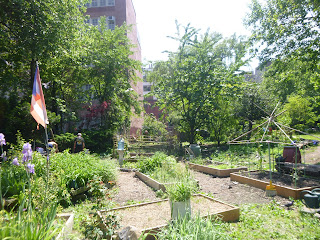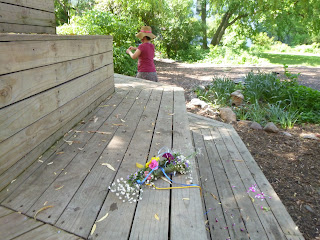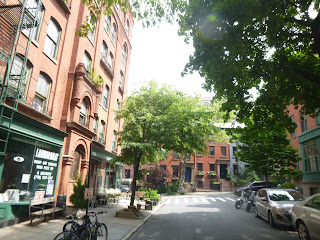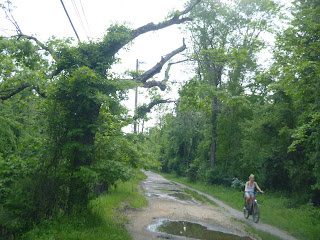Poems are always flying here -
Somes from the trees,
Others across the streets,
Murals on the walls.
Intersections between this life and that.
Bikes zip to and from.
Land / water
Down Jay Street, up the bike path, into the sky, the abyss.
Will the bike path hold?
Will it manage all these cars and bikes, all this weight?
Can it make it?
One day we won’t make it.
Could today be the day it crumbles, we stumble, tumbling through the sky, down to the water below, between the motion of light, disappearing into the dark water?
I’ve thought about that for years and years, day after day.
For a day, we make our way across.
Ferries crossing below.
Bike lanes surging.
Energy passing between us.
Land/water
Gardens beckon
Squatted spaces, green spaces returning, re emerging from the rubble.
Space ever transforming from Chinatown to the Lower East Side.
Land / water
Stories colliding.
Along with bodies,
Cars and bikes, ebikes zooming.
Bullets flying on the Q train, a store in Buffalo.
Land / water
Poets and sax players,
Puppeteers and gardeners,
A few of us are converging in the garden
Meeting for stories at Paradiso,
Puerto Rican flags down the street
Story after story.
Brennan and Elissa
Ann and Max
Tree house beckons.
Arriving, meeting, chatting,
Kids zip about.
Old trees welcome us, neighborhood friends.
“I was miserable, of course, for I was seventeen,
and so I swung into action and wrote a poem,
and it was miserable, for that was how I thought
poetry worked…” says Virginia.
Sharing Mingus at the Showplace, by William Matthews.
Sara reminds us of Frank O’Hara, who insisted:
“…Even trees understand me! Good heavens, I lie under them, too, don’t I? I’m just like a pile of leaves…One need never leave the confines of New York to get all the greenery one wishes—I can’t even enjoy a blade of grass unless I know there’s a subway handy, or a record store… It is easy to be beautiful…It's like a final chapter no one reads because the plot is over.”
I’m sure where the plot is leading.
Birds fly away as I walk through the garden, passing the casita on the 5th street side.
As usual a bunch of guys are sitting about.
The public space party is ever emerging and disappearing, a mirage through time.
Crickets hang out downtown from their locker in Time Square.
Flowers in the tree house.
Apologies on my phone.
It's too hot, says one.
Gotta go upstate says another regular.
Music plays.
It's too late to read.
Still Wendy, Anne and Harry, and the ghosts.
420 we are beyond the line, says Wendy.
Watch the buildings.
Watch the banks
Lets ride up to check out the digester eggs along newtown-creek.
On Kingsland Ave
I’ve got a new chain.
It's like butter.
“I’m nobody, who are you?
Oh you are nobody too,” Wendy concludes paraphrasing from Emily.
Ann is talking about the singularity, wondering what will become of us.
She reads Joy Harjo, stories of stars and poets just me and you:
“I was a star falling from the night sky - I needed you to catch me - I was a rainbow lifting from a dark cloud - I needed you to see me..”
I guess we all need each other from time to time.
Harry shares a birthday poem.
“Earth axes shifting in our chemistry.”
“I first started writing when I was a kid,” says Harry, as the conversation turns to poems themselves, those we write, or hope to write, those we feel compelled to grasp, even as they fly away, some our way, walking through the neighborhood, howls at our doorsteps, in our dreams.
“Fires in her heart, and her heart beats hotter, her heart beats harder than his drum” says Ann, reciting from her first East Village Poetry spoken word gathering at Exotic Cafe Confab.
“Don’t blue, let the rainbow out of you.”
The stories continue in countless directions.
On the way to Cambridge, we visited Amherst, taking in the trees down the street from the yellow house where Emily D wrote those 1800 poems on losses and friends and death, a lovable recluse for the ages, rarely leaving. A cemetery greeted us on the way out of town. Witches died here, noted @seashipsailing, reading poems into the night, parts of our lives and streets, our dreams and desires and reflections.
Gradually, more friends drop by, Elissa with her parasol.
And then Natalie, one of my favorite former students, with her kids, talking about mental health and struggles for public space.
And our conversation turns to nature, to Melville’s tale of the whale no one could quite conquer.
Nature will take over, says Ann.
Earth will be here for eons.
But will we?
Poetry is a way to purge, to be vulnerable, to be real, says Ann, reframing the conversation.
Try a haiku a day, punk rock bands murdered.
Two words, ideas.
Three lines.
With five syllables in the first line, seven the second, five the third.
Try it.
On we howl, reveling in the magnanimity Allen G knew, that we all know.
We have so much potential.
Can we ever bring back the commons?
The gardens are a commons.
I have this dream to make a physical cork board, with tons of stuff people are announcing, putting it up at Union Square, says Ann.
Harry worries about the machine people on hypocrite street.
The rest of us see something we attach ourselves to.
They are scared of the non-machines.
There is still beauty; the sun still rises.
One more by Joy Harjo:
“We were running out of breath, as we ran out to meet ourselves.
know the rumors of our demise. We spit them out. They die soon.”
“I am dreaming of a house just like this one…” says Sarah, from “Visitor” by Brenda Shaughnessy. “I was hoping to sit with you in a tree house in a nightgown in a real way. Did you receive my invitation?”
I didn't get one.
But JK did.
So did JC.
He couldn’t make it.
JC’s poem served a confession:
“My poem for tomorrow
I really want to go
And join you in the garden Tomorrow’s wonder.
But the rain’s pressing down
Saturating my presence For Saturday
With tenets-
Responsibilities, some name them-
chalk marks washed away.
Rain pelting meetings
Dropping tAsks Reflecting light on sidewalks of uncertainty-
Shining a semblance of authority
Drumming commitment (Some people wear suits)
But I know, as the water mounts,
It all amounts To a puddle.
A mere pile of water
Accumulated in a convex plane Signifying nothing.
To be splashed
And stomped
In hollering mirth
Or savagery.
This woeful ode
To take my place
In the springtime
Frolic
Of burning poems in burning daze.
My rage
My sage
My tender song
Rains down
Only to vaporize
In the sudden
Summer heat.”
In walks Peter, chatting about our movie and the farmer’s market.
Kids are running about.
Peter ignores them.
“I was kicked out of the farm stand,” he confesses.
We turn our attention to our never ending film of public space and its contested terrain, our stories of cities and their public spaces, bodies ever clashing in them, critical masses and gardens, Occupy and Sandy, the search for a commons, we’ve been part of for years now, as its disappeared and re emerged.
Kids are zipping about playing in El Jardin.
We reconvene at Le Petit Versaille, a quiet garden on E. 2nd Street.
“Public spaces are our living rooms,” says Natalie.
They are spaces for mutual aid, places to be authentic, to be ourselves.
They are vital for us to survive.
There’s no separation between us and public spaces.
We are our environments
You are the space.
We are.
Yet, some see them as threats.
They charge you to get inside.
Yet, we need them more than ever, as we saw in the pandemic.
People were stuck inside with no space to breathe.
Outside, we see so much, Natalie concludes, pointing out one final obstacle.
There are still too many cars, way too many cars.
I want you to be mayor, says Barbara.
“It's our birthright,” says Natalie. “Each of us benefit from it. Yet, people always want to monetize it. Yet, with climate change, we have to find another way, with less cars, and more innovation. Learn from Amsterdam. There are other models for cities.”
Barbara recalled a progression from Critical Mass to garden protection to Occupy to Black Lives Matter. “We started seeing the same people at the demos. And became obsessed with creating change, each day more, and gradually the activists I saw every day helped us gain power.”
The conversation extends through the years and the ways we look at our city and its stories.
It followed me, riding back to Brooklyn, to the Interference Archive, where some of the banners that we made all those years ago were on display as a part of a show about struggles for public space: "our streets!our city! Self determination and public space in NYC!", organized by my comrad @norasays. Walking, countless images fill the walls, flyers, banners, propaganda by my buddy @l.a.kauffman from our days in Lower East Side Collective and reclaim the streets days, tracing “past and contemporary strategies used by activists to reclaim or reimagine urban infrastructures.”
Riding back home, words from all the people, all the conversations, run through my mind,
Leslie Cagan, whose birthday we celebrated Monday, and all the years of protests, No War, no Nukes Marches, the clashes, fights over access to bike lanes, for a livable city, conflicts, battles between ideologies, between men and women, on and on, it runs through.
We have to live with each other and work with each other, says Alan Moore, whose in town giving book talks about his new memoir. The world is too small to stay in an argument.
We have to see the bigger picture.
We need each other, he tells me.
Al sat at our place for a bite as I got back home. It was my second time this week to see Al, who I meet most Wednesdays or Thursdays. He's still optimistic. "Unless there is a civil war I can't see anything changing, until we are all obliterated by climate change." Walking the streets of Brooklyn, I feel optimistic.
Corey Dolgan was more tongue and cheek, posting.
“In their race to the bottom, Missouri just passed legislation that bans abortion at moment o erection.”
I kept on dreaming about it throughout the night, the clashes, separations, unhinged, wondering, becoming lost in the cycles of history and conflict, our country ever ready to ban abortions and force mothers to bring kids into a world in which they kill or are killed in school, assault weaopons filling the streets, our eternal conflicts over god, guns, and bodies.
Out I ride into Brooklyn, still dreaming, on my way to the waterfront, clashing into a car parked in the bike lane on Smith Street.
Best not to double park in bike lanes, I find myself replying to the double parked car driver.
I was not the only one having troubles biking through the city. My friend Tedd Kerr was busy with his own ruminations: “A few weeks ago I was riding my bike, up hill, at night, in the rain. The journey echoed the tumult I was feeling inside. At one point, even though I was persevering through the weather, my inner life got the best of me. I had to stop. I found cover under a canopy of leaves and typed a tumble of words into my phone that would not leave me alone: I feel abandoned by the structural response to emergency. It was early spring and the death march towards normalcy that political and economic leaders were forcing us to make had become that much harder to avoid…what to do amid raising gas prices and Roe v. Wade being overturned; as social media is clogged with people making fun of Amber Heard…many of us thinking again of the early (and ongoing) days of AIDS. But also, the past I'm talking about is not that long ago. It is kinda wild to think about how only two years ago many people left lock down for the first time to march for Black Lives. We attempted to social distance as we gathered to mourn, we handed out food as we marched, and chanted through our masks. A current push towards some idea of a pre-pandemic life is not disconnected from a drive to make what we are living through seem like something we lived through.”
Recovering from the crash, I cruise back down to the East River, meeting Kevin at the WO Decker, “the last surviving New York-built wooden tugboat” at the Seaport.
We’d spen the morning on the waterfront, howling about the East River, crossing the Brooklyn Ferry… where he was leading a tour, “[h]opping on and off NYC's superb East River Ferries, explor[ing] the 10,000–year history of the lower East River waterfront of both Brooklyn and Manhattan.” All morning, “Dr. Kevin Dann narrate[s] the epic story of this channel's cultural and environmental past, focusing on the lives of those who have worked and played here. Beginning with a short walk through the South Street Seaport to Pier 11, up to North Williamsburg, debark[ing], then ferry to DUMBO for an in depth look at Brooklyn's historic shoreline. … enjoying poetry, song, and story from a native New Yorker who has lived and worked on both sides of the river, and written about its colorful past in books, plays, and novels.”
“When I was 14, I fell in love with Walk Whitman,” confessed Dann, in between stories of pirates and mobsters, vying for space along the liminal waterfront.
Dann’s grandfather was his guide to NYC and its waterfront.
Without the ferry, New York would have never happened, he insists, referring to Fulton’s ferry that crossed from Brooklyn to Manhattan and back during much of the 19th and early 20th century.
Up past Stuyvesant Town, Dann points to Stuyvesant Town, named for Peter Stuyvescent, the first Dutch colonial governor here in 1647, learning about Manhatta the "hilly island," of the Lenape People.
“The heavy wind pulled the driver off the haligot,” says Kevin, referring to the the ferry rides on
Fulton Ferry, the original steam ferry connecting Manhattan and Brooklyn.
“How do we pull together?
How do we navigate the winds of the modern world.
We have to do it together?
There is no place more erotic than the water!” Dann exclains.
“Anything could happen. We could find that on the river…”
That was the experience for a lot of us.
“away you rolling river…” Kevin sings, “wide open to sing together.
We make a prayer together for the poets.”
The whole river seems to scream with their stories.
Dann reminds me of Speed Levitch, in the Cruise, touring us through his distinct brand of philosophy, channeling “the lascivious voyeurism of the tour bus.”
“The steamboat killed Roebling,” say Dann.
“And Roebling killed the ferry,” he quips back, referring to the designer of the Brooklyn Bridge, who was killed by boat as they stood on a dock on the 28th of June 1869.
The Ferry ended on 1924.
Everyone was comfortable walking the bridge instead, driving or biking.
The East River Ferry across the water would not begin again until 2011, only another eleven years before the city would start bulldozing the trees of East River Park to save us from the rising tides, ever surrounding and possibly engulfing the city.
“For 100 years, the city ignored the water,” Dann rants.
“The dead are never dead. The dead are never gone.”
On we cruise up the river and down, past the shuttered Domino Sugar Factory and Navy Yards, past New York’s industrial remains, still along the waterfront, ever transforming from sites of work to play. Yet, access to the water is limited, often privatized.
“How curious you are to me,” says Walt Whitman, Crossing the Brooklyn Ferry, in his day, imagining us doing the same, generations later, still navigating the space between land and water.
“In the presence of the dead, it nourishes your soul,” says Dann, looking as we make our way to the Fulton Ferry landing, in front of the River Cafe, looking at the Walt’s old newspaper offices for The Eagle, at 28 Fulton Street.
“Flow on flow with the flood tides,” says he poetry at the docks, Walt’s words, time blurring, light shining on Brooklyn's original, 1642 ferry landing.
Across the water, our eyes take us to Manhattan, the raging city, even churning.
And I keep moving.
All day, we listen to Leonard Cohen records, zipping about, moving, walking, imaging, over bridges, to Princeton and back, wondering what will become of us, between here and there, on the Goethals Bridge, connecting Elizabeth New Jersey with Staten Island, wondering if it will hold or if this is the moment we come crashing back into the water.
“"I'd like to tell my story"
Said one of them so young and bold
"I'd like to tell my story."
“The mark of a good song is if you can listen to it as you go down,” says the little one, my travel companion on the way back after lunch and a hike along the D and R trail.
Back to Brooklyn, back over the Bridge, I ride to East River Park, where poems are rising and trees are disappearing.
meeting, you’re bigger you’re wiser you’re stronger
than me, and always will be. Each of us walking
Riding through the maze of construction equipment and people trying to enjoy last moments before the park is completely destroyed, I arrive at 6th street rrove under a few remaining trees.
Reverend Billy is preaching to the trees. Some 700 have been killed in the last few months, more in the coming months. The Earth Church is “meeting at East River Park to say goodbye to the grove of trees before they’re cut down.”
“Listen to the trees. Listen to the earth” says @revbillytalen ... “Learn about the hidden life of trees… How do we learn to inhibit this Hieronymus Bosch image of destruction along the edge of the East Village? This is alive to the South Street Seaport. These roots are still alive. The Earth is still alive, even if it looks like Maripol, it's still alive. Trees talk. Talk to me. Talk to us. We’re gonna listen. I’m listening. Feel the breeze, feel the wind.”
Dozens of us are listening under the trees.
One is Allen Moore, the East Village artist, in town by way of Madrid.
“They did the same thing in Atlanta. They started with burning the trees. Thats how they started,” he quips.
On Talen preaches:
“Can you hear the earth?
Yes, I hear the earth.
Each of us is a talking ecosystem.
I got apocalypse fatigue.
Beautiful world.
Love runs wild.
The sixth extinction is coming.
Bill DeBlasio’s bulldozers are taking the lead.”
“We can find ways to work together,” says Allen.
We have to. The city is too small otherwise.”
Save the trees; save ourselves. Save the gardens, save ourselves, I think, reflecting on land and water and the spaces in between riding back over the Manhattan Bridge, water below, once again, back to land, along that space in between.



































































































































No comments:
Post a Comment